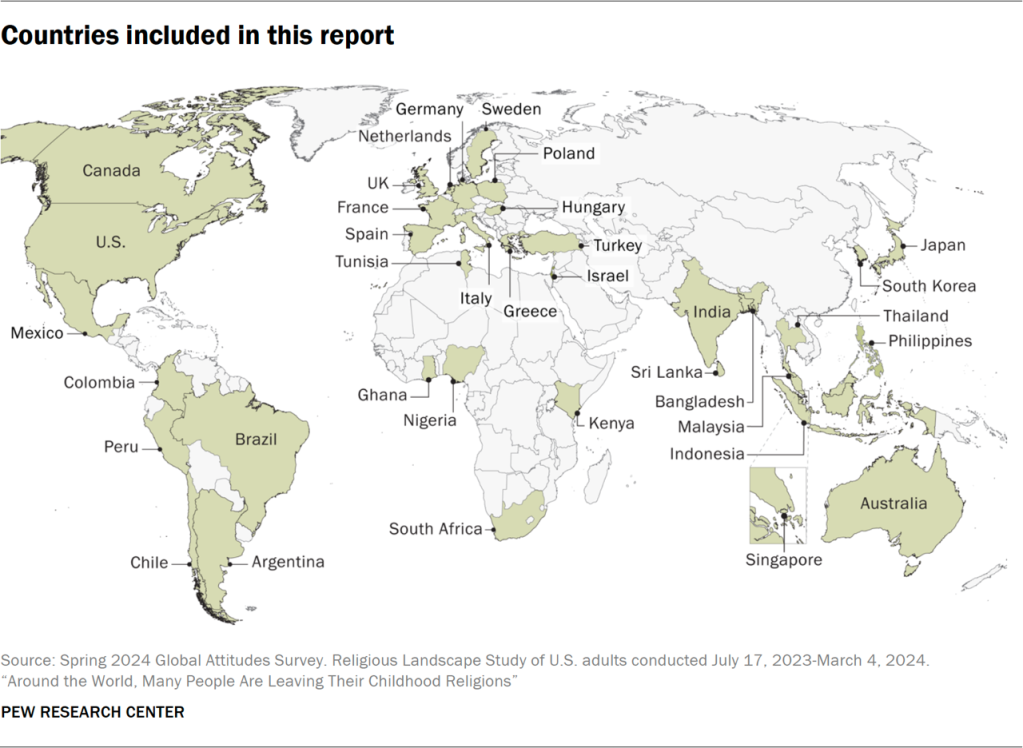Surveys in 36 countries find that Christianity and Buddhism have the biggest losses from ‘religious switching’
In many countries around the world, a fifth or more of all adults have left the religious group in which they were raised. Christianity and Buddhism have experienced especially large losses from this “religious switching,” while rising numbers of adults have no religious affiliation, according to Pew Research Center surveys of nearly 80,000 people in 36 countries.
Rates of religious switching vary widely around the globe, the surveys show.
What is religious switching?
Throughout this report, religious switching refers to a change between the religious group in which a person says they were raised (during their childhood) and their religious identity now (in adulthood).
We use the term religious switching instead of “conversion” because the changes can take place in many directions – including from having been raised in a religion to being unaffiliated.
We count changes between large religious categories (such as from Buddhist to Christian, or from Hindu to unaffiliated) but not switching within a world religion (such as from one Christian denomination to another). Refer to the Terminology section for details.
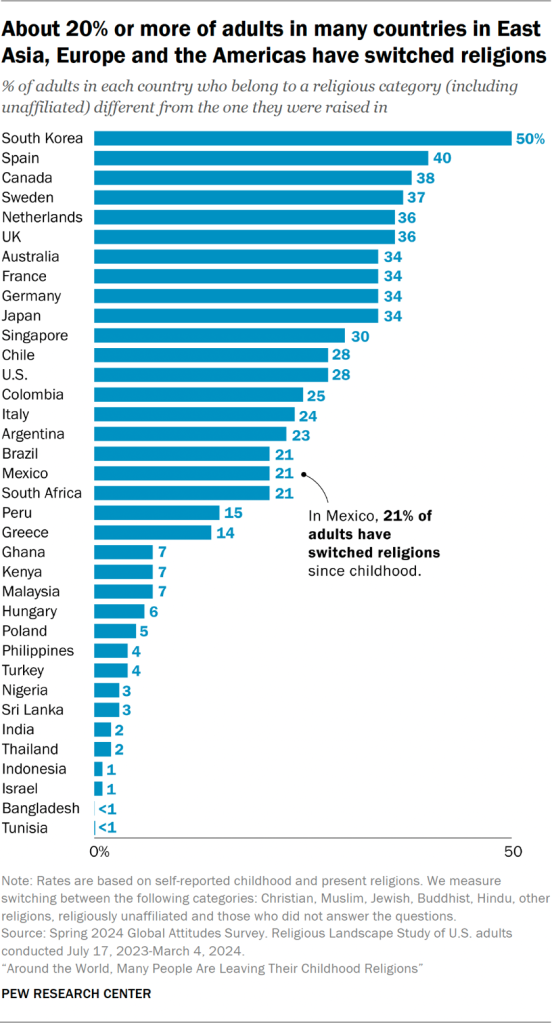
In some countries, changing religions is very rare. In India, Israel, Nigeria and Thailand, 95% or more of adults say they still belong to the religious group in which they were raised.
But across East Asia, Western Europe, North America and South America, switching is fairly common. For example, 50% of adults in South Korea, 36% in the Netherlands, 28% in the United States and 21% in Brazil no longer identify with their childhood religion.
Which religions are people switching to?
Most of the movement has been into the category we call religiously unaffiliated, which consists of people who answer a question about their religion by saying they are atheists, agnostics or “nothing in particular.”
In other words, most of the switching is disaffiliation – people leaving the religion of their childhood and no longer identifying with any religion.
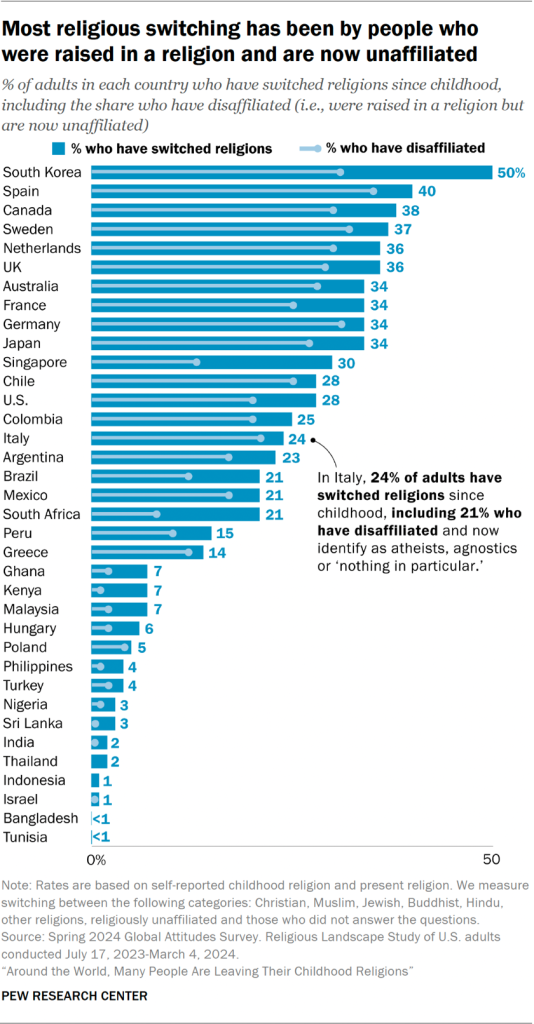
Many of these people were raised as Christians. For example, 29% of adults in Sweden say they were raised Christian but now describe themselves religiously as atheists, agnostics or “nothing in particular.”
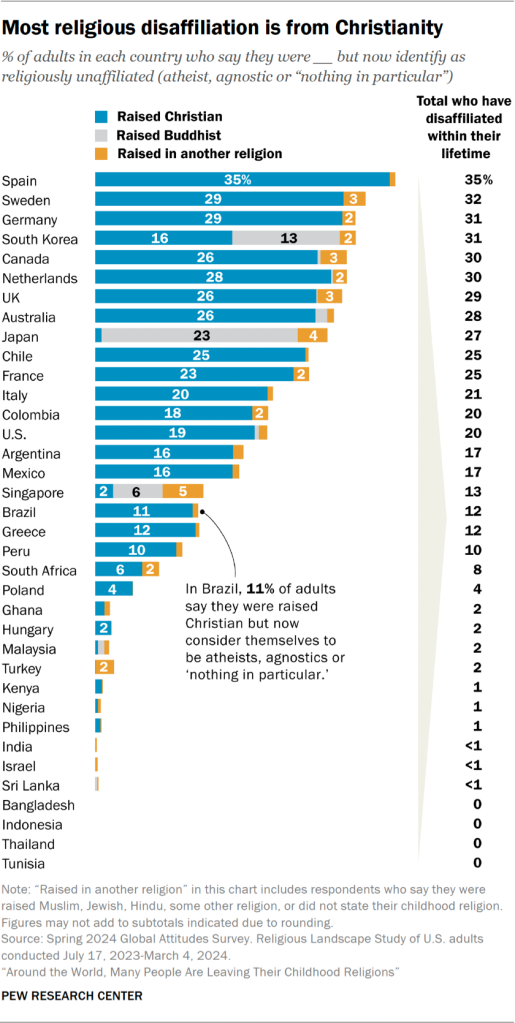
Buddhism also is losing adherents through disaffiliation in some countries. For example, 23% of adults surveyed in Japan and 13% in South Korea say they were raised as Buddhists but don’t identify with any religion today.
However, not all switching is away from religion. Some people move in the opposite direction. Of the 36 countries surveyed, South Korea has the highest share of people who say they were raised with no affiliation but have a religion today (9%). Most of them (6% of all South Korean adults) say they had no religious upbringing and are now Christian.
Additionally, about one-in-ten or more adults in Singapore (13%), South Africa (12%) and South Korea (11%) have switched between two religions.
While these figures reflect religious trends in the 36 countries included in the survey, they are not necessarily representative of the entire world’s population. Christianity – the world’s largest and most geographically widespread religion, by Pew Research Center’s estimates – is either the current majority faith or historically has been a predominant religion in 25 of the countries surveyed.
Islam, the world’s second-largest religion, is a historically predominant religion in six of the 36 countries surveyed: Bangladesh, Indonesia, Malaysia, Nigeria, Tunisia and Turkey. (We consider both Christianity and Islam to predominate in Nigeria, which is closely divided religiously.)
Buddhism has been predominant in five other countries surveyed: Japan, Singapore, Sri Lanka, South Korea and Thailand. (We also count South Korea as having two predominant religions, Buddhism and Christianity.)
Hinduism and Judaism are each the predominant religion in just one country surveyed (India and Israel, respectively).
Other questions answered in this Overview:
Which religious groups have experienced the largest losses from religious switching?
Another way of analyzing religious switching is to examine net gains and losses – how many people have entered and how many have left each religious group.
Net gains and losses can be expressed as a ratio: For every person who has left, how many people have joined a particular religion?
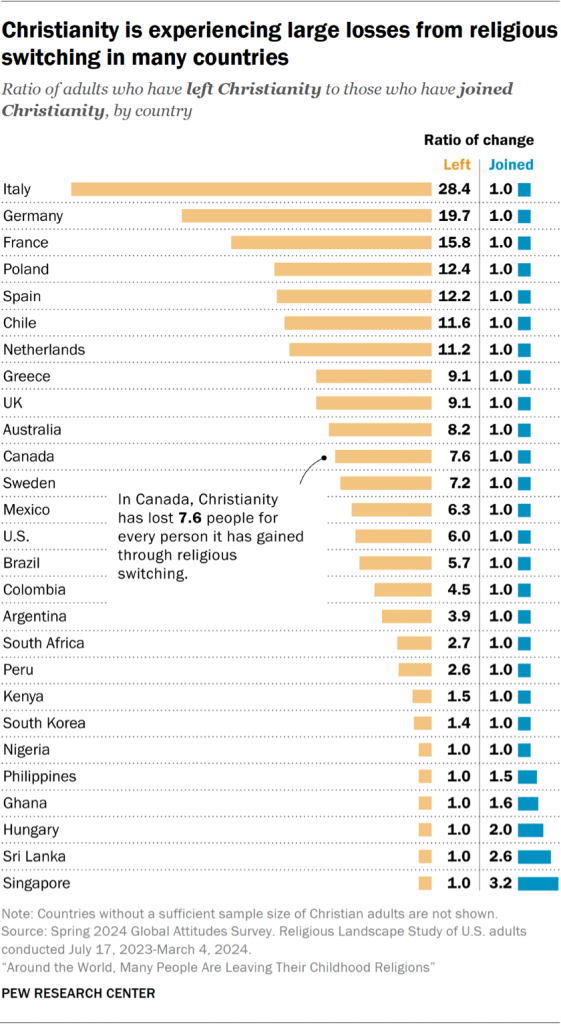
In most of the countries surveyed, Christianity has the highest ratios of people leaving to people joining – the largest net losses.
In Germany, for example, this ratio among Christians is 19.7 to 1.0, meaning there are nearly 20 Germans who say they were raised as Christians in childhood but don’t consider themselves Christian today for every one German who has become a Christian after being raised in another world religion or in no religion.
In a handful of countries, though, Christianity is making small gains from religious switching. In Singapore, for instance, the ratio among Christians is 1.0 to 3.2. For every Singaporean who has left Christianity, about three others have become Christians.
And in a few other places, roughly equal numbers of people are leaving and joining Christianity. For example, the ratio in Nigeria is 1.0 to 1.0.
(Read more about switching into and out of Christianity in Chapter 1.)
The survey also shows that Buddhism is experiencing large losses from religious switching – mostly disaffiliation – in a few countries, such as Japan, Singapore and South Korea.
However, the leaving-to-joining ratios are not as high as those for Christianity. For instance, in Japan – the country with the largest percentage of people who say they were raised Buddhist but are no longer Buddhists – the leaving-to-joining ratio among Buddhists is 11.7 to 1.0.
(Read more about switching into and out of Buddhism in Chapter 3.)
Which religious group has gained the most from religious switching?
The category that has experienced the largest net gains from switching is the religiously unaffiliated.
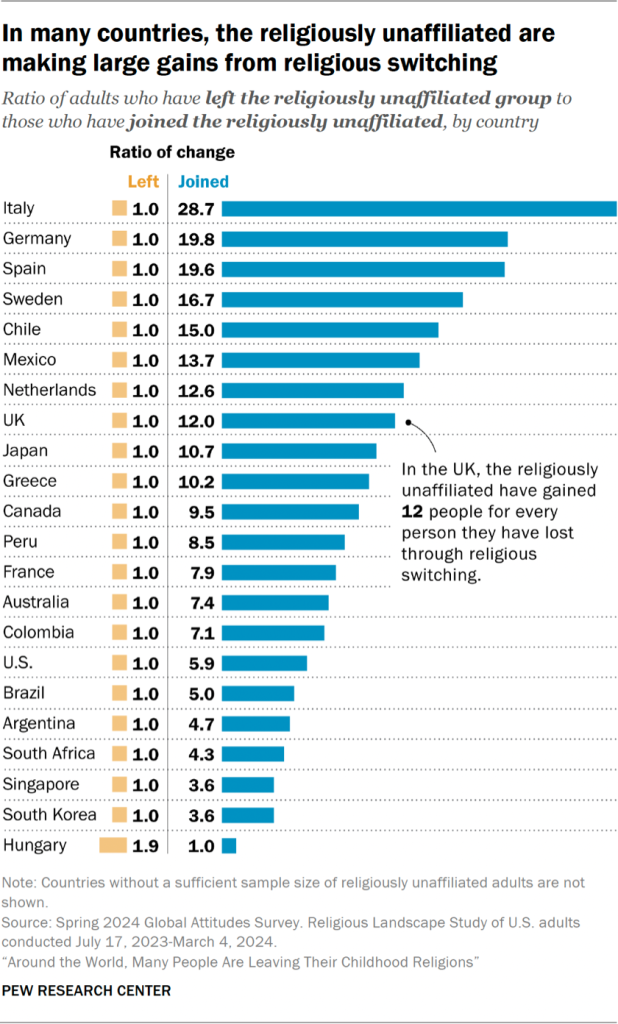
In countries with substantial numbers of people who describe themselves as having no religion – sometimes called “nones” – many more survey respondents have become unaffiliated than have joined a religion after being raised without one.
In Italy, for example, the ratio of leaving to joining among the unaffiliated is 1.0 to 28.7. For every person who was raised without a religious affiliation but who now has a religion, more than 28 people say they were raised in a religion but no longer have one.
However, in Hungary, this is not the case. For every Hungarian who has become religiously unaffiliated, nearly two others say they were raised without a religion but now identify with one (a leaving-to-joining ratio of 1.9 to 1.0). Most of the Hungarians who have taken on a religion after being raised without one are now Christians.
(Read more about switching out of the religiously unaffiliated category in Chapter 2.)
Are there differences in religious switching rates by age, education or gender?
Age
In most countries surveyed, roughly equal percentages of younger and older adults have switched religions. For example, in Singapore, 29% of adults between the ages of 18 and 34 say they belong to a religious group that is different from the one in which they were raised, as do 29% of adults older than 50.
However, in 13 countries – including nearly all Latin American nations surveyed, as well as several countries in Europe and North America – adults under 35 are more likely than adults ages 50 and older to have switched religions.
In Spain, for instance, 48% of 18- to 34-year-olds have switched religions since childhood, compared with 36% of adults ages 50 and older. And in Colombia, 34% of the youngest adults have switched religions, compared with 14% of the oldest adults.
In Australia, however, younger adults are slightly less likely than older adults to have switched religions (32% vs. 37%).
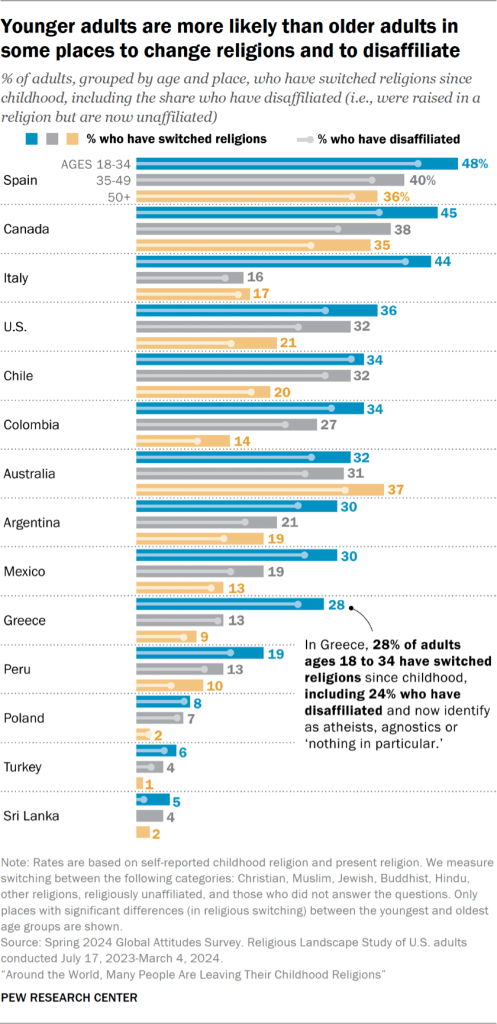
In most cases, the bulk of the switching in all age groups is disaffiliation – much of which is people leaving Christianity. But the rates of disaffiliation are often higher among young adults. In Colombia, for example, 26% of 18- to 34-year-olds say they were raised as Christians but no longer identify with any religion, compared with 9% of Colombians ages 50 and older.
Because the survey questions pick up changes that have happened at any time since childhood, it is not possible to know whether the adults older than 50 who have disaffiliated did so recently or long ago, perhaps when they were in their teens or early 20s. Some older adults may have disaffiliated when they were young and then came back to a religion as they aged.
In short, these age patterns might be signs of secularization, indicating that countries like Spain, Canada, Italy and the U.S. are gradually becoming less religious. However, it’s also possible that some of the age differences in religious affiliation revealed in a single survey (or multiple surveys conducted at the same point in time) could result from people becoming more religious as they grow older.
Education
In most countries, rates of religious switching don’t vary a great deal between people with different levels of education.
However, in 12 of the 36 countries surveyed, people with more education tend to have higher rates of religious switching.
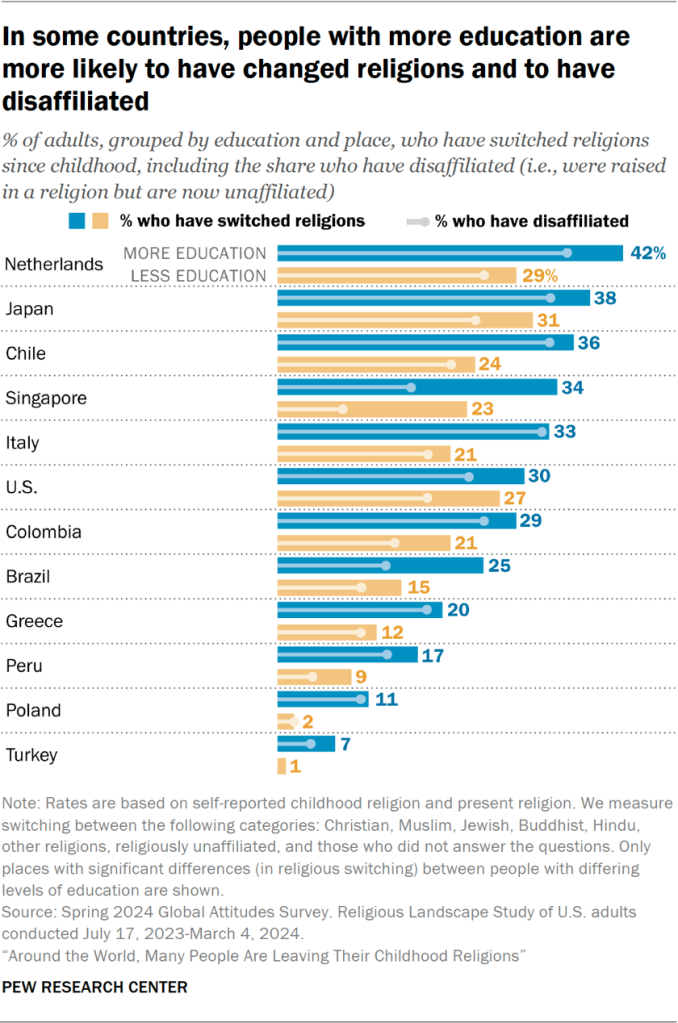
Once again, most of the switching by people at each level of education is disaffiliation – in particular, people who say they were raised in a religious tradition (often as Christians or Buddhists) but no longer identify with any religion.
The Netherlands displays the largest differences in switching rates by education: 42% of Dutch adults with higher levels of education (a postsecondary degree or higher) have changed religions since childhood, compared with 29% of Dutch adults with lower levels of education.
Gender
Likewise, in most countries surveyed, roughly equal percentages of women and men have changed religions. For instance, in South Korea – the country with the largest share of adults who have switched religions – 51% of women and 50% of men have changed religions over the course of their lives.
But in six countries, there are statistically significant differences in switching rates by gender, with men more likely than women to have switched religions.
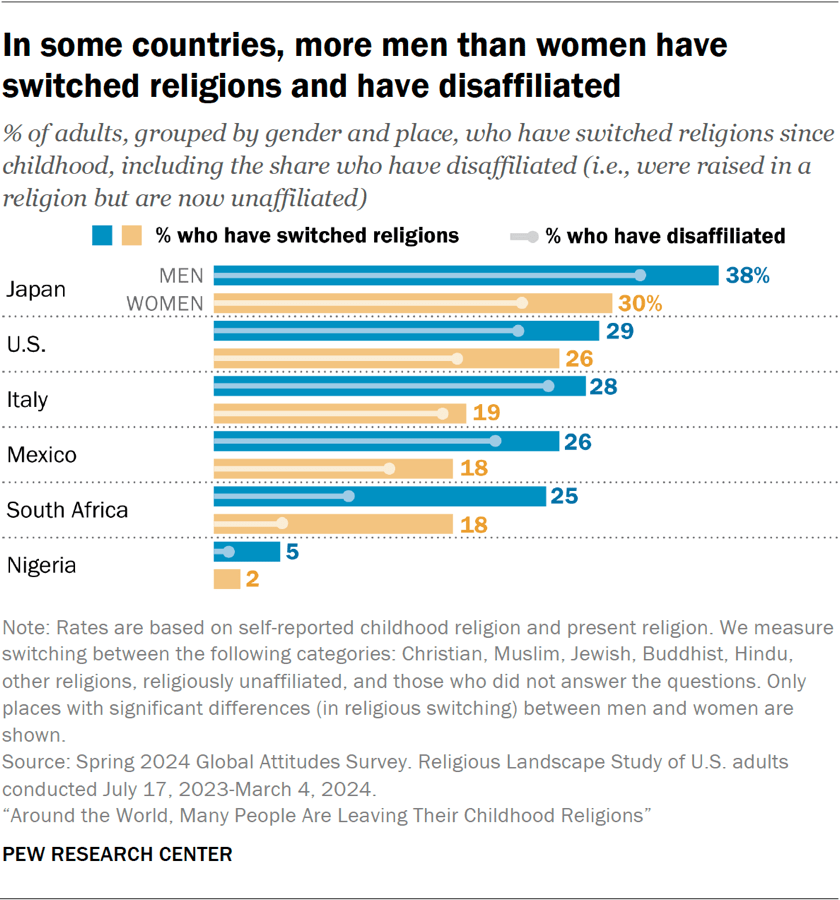
And, as with the differences by age and education, much of the switching among both men and women is disaffiliation – especially from Christianity or, in Japan, from Buddhism.
Other key findings in this report
- Across the countries surveyed, most people who currently identify as Christian were raised as Christians. Among the smaller numbers who have become Christian after being brought up in a different way, most say they were raised as Buddhists or religiously unaffiliated. (Chapter 1 discusses switching into and out of Christianity.)
- Most adults who are now religiously unaffiliated say they were raised in some religion – in many cases, Christianity or Buddhism. (Chapter 2 covers switching into and out of the unaffiliated category.)
- In some countries, Buddhism has declined due to religious switching, while in other countries, it has remained relatively stable. (Chapter 3 examines switching into and out of Buddhism.)
- Very small percentages of the overall adult population have left or joined Islam in most of the countries surveyed. (Chapter 4 discusses switching into and out of Islam.)
- Most people who were raised Jewish in Israel and the U.S. still identify this way today, resulting in high Jewish retention rates in both countries. (Chapter 6 discusses switching into and out of Judaism.)
- Nearly all people who were raised Hindu in India and Bangladesh still identify as Hindu today. (Chapter 5 covers switching into and out of Hinduism.)


